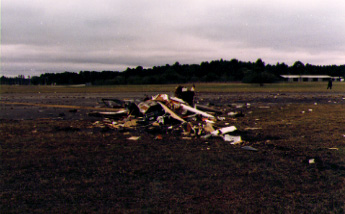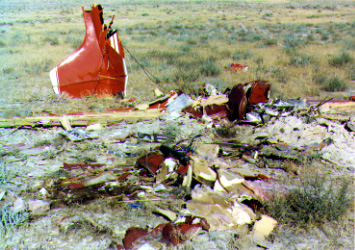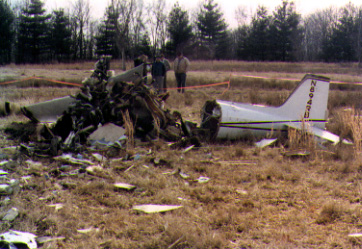How to Kill Yourself in a Homebuilt Airplane
![]()
How to Kill Yourself in a Homebuilt Airplane |
|
by Alfred Scott
|
This article appeared in the March 1992 issue of the Falco Builders Letter. |
Whenever there's an accident in an airplane, there's a natural tendency in all of us to dismiss the mistakes that others have made as something we would never do. We sagely recount the unfortunate pilot's error-he ran out of gas... tried to take off with... tried to do a roll-all things that somebody else did. And if it's in another type of airplane, then we sneer at that, too.
But there's a harsh reality we should all face up to, with so many high-performance homebuilts now flying, there's a pattern of accidents that's undeniably there, and any designer, kit supplier or pilot who tries to paint this problem as a 'Brand-X' problem-you know, that other design-is simply over-exercising his arrogance.
So let's take a look at the problem, see what lessons can be learned, and ask how all of us can make a difference.

In the case of the Falco, we've had three fatal accidents out of the first thirty or so Sequoia Falcos to fly. In two of these, the pilot was on literally his second flight in the plane. One took off with essentially no fuel in the tanks and then attempted to turn back to the field when the engine stopped. The other appears to have attempted aerobatics. In the third accident, the pilot was on his first instrument flight and ended up low on fuel, shooting a back-course approach from the right seat, on a rainy night that was right down to the minimums. They were obviously quite scared and ran out of fuel right over the field, tried a sharp turn to the runway, stalled and crashed.
The Smythe Sidewinder has lost more than 30% of its fleet to stall-spin accidents, yet the airplane has a perfectly normal configuration and with no obvious flaws. But it was the Glasair III that finally got everyone's attention. With about 38 flying, during one six-month period six airplanes were totaled. There's simply no way to ignore such things.
What got me started on this was a conversation with Dave Noland of The Aviation Consumer. We were talking about the accident rate among high-performance kitplanes, and Dave mentioned the experience of the Grumman American Yankee. Some years ago, he had done a story on the plane, which had a terrible accident rate-the worst of any production single by a country mile.
And when they looked at the statistics, one thing stood out: almost without exception, the accidents were occuring to pilots who had very little time in the Yankee. Total time in all airplanes made very little difference. It didn't make any difference if you had 100 hours or 5,000 hours in other planes-what mattered was whether you had only a little time in the Yankee. (By 'Yankee', I mean all of that family of airplanes, from the original stubby-winged Bede design to the LoPresti-cleaned-up 180-hp Tiger.)

The American Yankee Association did something about it, and the results are astonishing. About three or four years ago, they started a pilot familiarization program. There are about 20 to 30 check pilots, who must be CFIs, scattered around the country who take a pilot through a familiarization program. The curriculum is standardized and focuses on the peculiarities of the Yankee-the castering nosewheel, the sensitivity in pitch and roll, the need to be 'on airspeed' on approach (particularly with the early models), porpoising on landing, etc.-but there is no required number of hours for the program. It is up to the check pilot to say when the pilot is comfortable with the airplane.
Complete this familiarization program, and you will qualify for a 10% discount on your insurance. That's nice, but the real payoff is in the accident rate, which has gone to essentially nil since the program began.
Avemco's vice-president of underwriting, Jim Nelson, confirmed that this is the same syndrome that they found with the Glasair III. Many of the airplanes were professionally built and then test-flown by the owner who found himself at the stick of a very high performance aircraft.
The Glasair III is a very-high-powered, high-wing-loading airplane. It was like jumping into a P-51 without proper training. Lose an engine, and you come down at 2600 fpm.
And worse yet, in the opinion of many experts, there was a lot of bad advice floating around on how to fly the plane. Pilots were being told to fly steep approaches which caused landing accidents. You fly the plane like a turbine corporate twin, say the experts, with a normal approach angle and carrying a bit of power right down to the pavement.
Avemco also became worried about the quality of the construction. Stoddard-Hamilton told The Aviation Consumer that one recently totalled Glasair was deemed unrepairable simply because the airplane had been too ineptly constructed to make restoration viable. There are concerns about contaminents in the fuel tanks, overall construction quality, and of course everyone is concerned about modifications.
In order to provide insurance, it was necessary to find a way to ensure that the aircraft was airworthy, repairable, and that the pilot was trained to fly it. The Sport Aircraft Manufacturers Association, Stoddard-Hamilton, and Avemco put together a program to make insurance available under certain conditions.
First, they require an initial inspection for overall quality. They want to know from the beginning it is built right and can be repaired if crashed-you can bet that Avemco has insured its last not-worth-repairing Glasair. This inspection is in addition to the FAA inspection, and it typically takes 30 to 40 hours of labor.
Second, they wanted to be sure that the pilot could fly the aircraft. Working with PIC (Professional Instrument Courses), they established an initial and recurrent training program. Pilots are required to take annual recurrency training. The training covers slow flight, stalls, problems with gear extensions, etc.

Do all this and Avemco will insure you. Don't comply, and you can buy your insurance elsewhere, thank you very much.
This approach is definitely the coming thing. The initial inspection will vary with the aircraft, and will probably only be required with certain aircraft where the insurance company has concerns about the ability to repair the airplane and to find someone who can do the work. The conventional methods of construction-steel tubing, fabric-covering, wood, and aluminum-are all things they've dealt with for years.
And the requirement for a formal training program will initially apply only to the Glasair III, but owners of other high performance, high powered airplanes-Lancair IV, Venture, SX-300, etc.-can count on it.
But just because an airplane like the Falco has a moderate wing loading and average approach speed is no reason to relax. The Yankee was considered 'real sporty' in its day, but the Falco has much lighter controls, a faster rate of roll and greater sensitivity in the controls, even though it may be easier to land.
Avemco would like to see a training facility for every high performance airplane, and you really can't argue with the benefits of a such a program. Insurance-enforced training already exists for a number of complex twin-engine aircraft, and we're going to see more of this sort of thing with high-performance homebuilts.
I love the idea, myself. Insurance companies make decisions based on their experience in the field. Some years ago when I owned an old Victorian apartment building, we found it was the insurance companies who really laid down the law with us on safety issues-not municipal building inspectors with their building codes. Insurance companies were free to lay down a new list of requirements each year, they were always tough on us, and I always found them to have good reasons. (In fact, I hold the opinion that if the FAA got completely out of the certification business and left it all to the insurance companies, we'd have safer airplanes.)
Overall the safety record of homebuilt aircraft is not greatly different from production aircraft. There are slightly fewer fatalities per aircraft (which is slightly deceptive because homebuilts have fewer seats on the average) and slightly more accidents. The mix is different: lots of low-altitude buzzing accidents, not many weather-related mishaps, and aerobatics are thought to be a factor contributing to the slightly higher rate among homebuilts.
But here's the predictable part: approach the transition to the Falco with the same rather cavalier attitude that's been practiced in the past, and some of you reading this will die as a result.
If that's not appealing to you, then here's what we can do. Let's start by recognizing that it's smart to get checked out in the Falco by an experienced pilot. Builders who have finished their Falcos have been quite good about giving people rides, but let's recognize that it's not just a matter of being nice-it's saving lives.
I think it's time we put together a familiarization guide for the Falco, a syllabus of all of the things that are different about the Falco, and a formalized curriculum to introduce pilots to the Falco. I'd love to have suggestions and contributions from any of you.
|
|